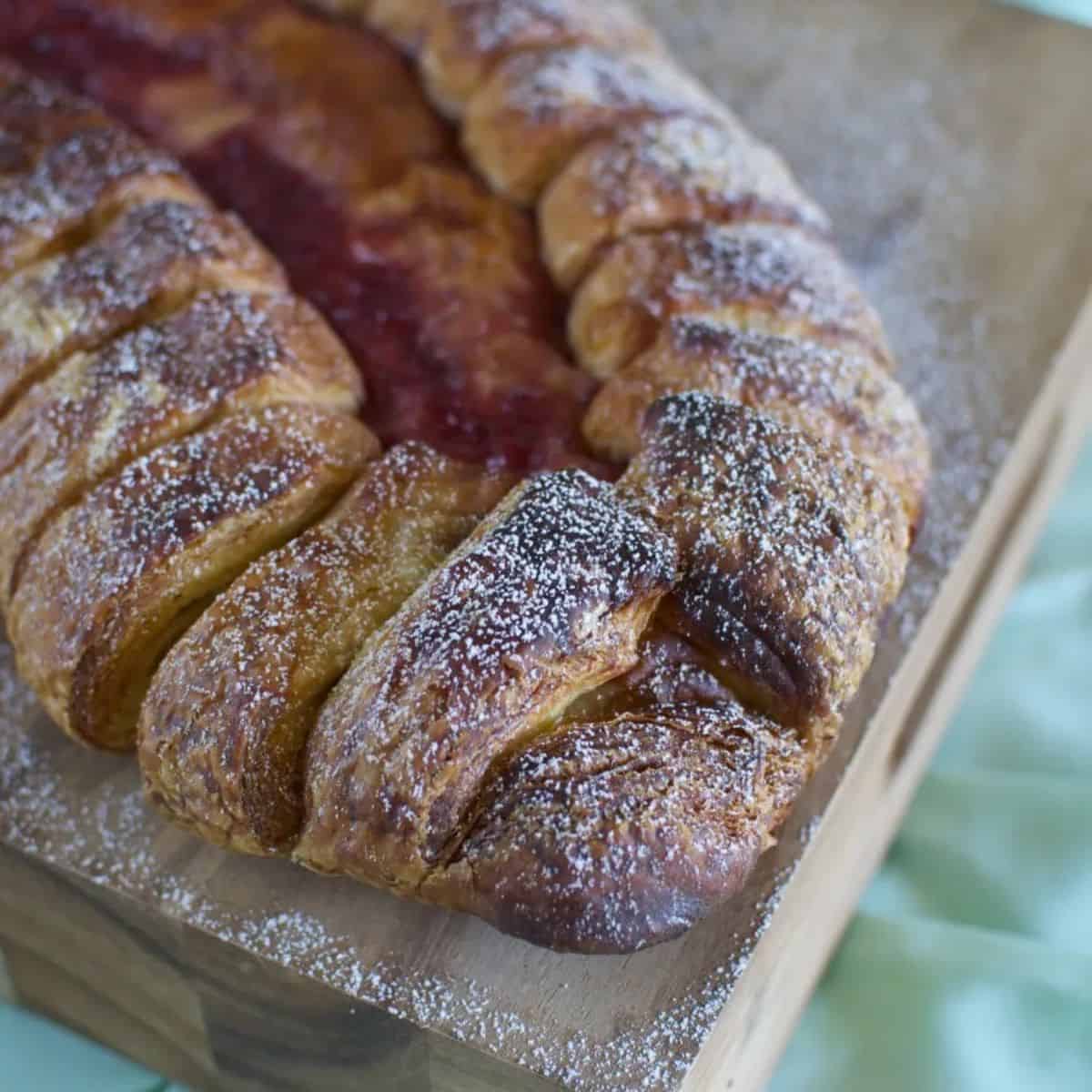
Strawberry Danish braid
Impress your family or guests with this beautiful strawberry Danish braid—it's surprisingly easy to make and the results are bakery-worthy. With flaky pastry and sweet, juicy strawberries, it's the perfect treat for weekend brunches or special occasions.
Print
Pin
Save
Servings: 1 giant loaf
Calories: 3742kcal
Ingredients
Dough (Detrempe)
- 1 tablespoon active dry yeast
- ½ cup full-fat whole milk
- ⅓ cup caster superfine sugar
- Zest of 1 orange finely grated
- ¾ teaspoon ground cardamom
- 1 ½ teaspoon vanilla bean paste
- 2 large free-range eggs chilled
- ¼ cup fresh orange juice
- 3-¼ cups plain AP flour
- 1 teaspoon salt
Butter block (Beurrage)
- 250 g 2 sticks cold unsalted butter
- ¼ cup plain AP flour
Braid
- 1 quantity dough as above
- 1 cup strawberry jam
- 2 tablespoon of milk or one egg beaten
Instructions
- In the bowl of an electric mixer, beat the yeast and milk until just mixed together.
- Add the sugar, orange zest, cardamom, vanilla, eggs and orange juice and beat until well combined.
- Swap over to the dough hook and add the salt then with the motor running, slowly add the flour.
- When all the flour is mixed in, increase the speed to medium and knead for about 5 minutes or until the dough is smooth and no longer sticky (add a little extra flour if need be).
- Form the dough into a ball and place on a floured plate, cover with plastic wrap and refrigerate for 30 minutes.
- Meanwhile make the Beurrage.
- In the bowl of an electric mixer, beat the butter and flour together for one minute.
- Scrape down the bowl then beat the mixture for another minute or until it is smooth then set the bowl aside.
- When the dough has been in the fridge for 30 minutes, take it out and turn it out onto a floured surface.
- Roll the dough out to a rectangle approximately 35x25cm (18x13")and ½cm (¼") thick.
- If the dough is still sticky, dust it with a little bit more flour.
- Mentally (or with a little cut in the dough, divide it into thirds then spread the middle and right thirds with the butter mixture.
- Fold the left third of the dough over the middle of the dough to cover half the butter (sorry if this is a lot of maths!) then fold the right third over to form an envelope shape. Place the dough on a floured plate or something flat, cover it with plastic wrap and refrigerate for 30 minutes.
- That was the first turn. This needs to be repeated three more times for a total of 4 turns with 30 minutes refrigeration between each one.
- Each time, place the dough in front of you so that the open ends are your right and left then roll it out to the same size as above but you won't add anything this time just fold the thirds over and refrigerate again.
- After the final turn, the dough will need to be refrigerated for at least 5 hours or over night. If you're not going to bake it the next day, roll the dough out to 1 inch (2cm) thickness, wrap the dough in two layers of plastic wrap and refrigerate for up to 1 month. To defrost, place in the fridge over night.
- Line a baking tray with baking paper and set aside.
- On a lightly floured surface, roll the dough out to a 30x40cm (15x20") rectangle, ½cm (¼") thick.
- If the dough keeps bouncing back, just leave it to rest for a few minutes then try rolling it again.
- When it is rolled to size, transfer to the baking paper.
- Along one lone size of the dough, use a pizza cutter or sharp knife to make cuts ⅓ of the way across the dough leaving 2cm (1") between each one.
- Repeat on the other side of the dough making sure the cuts are aligned.
- Spread the filling down the middle, un-cut section of dough.
- Starting with one side, fold a flap down over the filling but on a light angle so it meets the start of the next cut on the other side, not the one it lines up with.
- Fold the first flap from the other side up and over it to cross it then repeat, alternating, all the way down the dough.
- Tuck in the ends.
- Use a brush to paste on the milk or egg wash.
- Lay a large piece of plastic wrap on the bench top and spray it with oil.
- Turn it onto the dough to cover it then leave it to rest for 2 hours or until doubled in size.
- When it has nearly risen, pre-heat the oven to 180C (400F) fan-forced.
- Bake the dough for 10 minutes then take the tray out and turn it around and turn the oven down to 160C (350F) and bake for a further 15-20 minutes or until golden.
- Serve warm from the oven or slice it up and toast the slices.
- I stashed my slices away in the freezer for quick delicious snacks.
Nutrition
Calories: 3742kcal | Carbohydrates: 418g | Protein: 35g | Fat: 218g | Saturated Fat: 134g | Polyunsaturated Fat: 10g | Monounsaturated Fat: 57g | Trans Fat: 8g | Cholesterol: 883mg | Sodium: 4231mg | Potassium: 986mg | Fiber: 9g | Sugar: 249g | Vitamin A: 7093IU | Vitamin C: 61mg | Calcium: 399mg | Iron: 10mg
Have you made this recipe? I'd love to hear what you think. Tag me on Instagram @clairekcreations